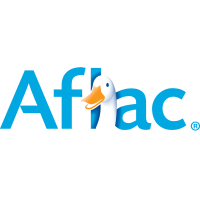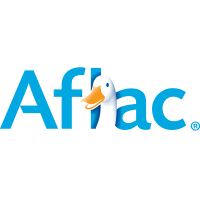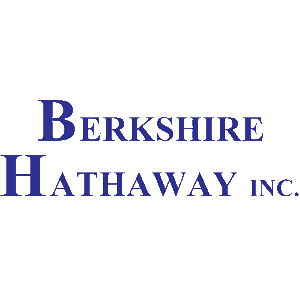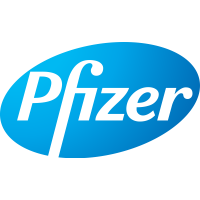
Aflac Inc
NYSE:AFL


| US |

|
Johnson & Johnson
NYSE:JNJ
|
Pharmaceuticals
|
| US |

|
Berkshire Hathaway Inc
NYSE:BRK.A
|
Financial Services
|
| US |

|
Bank of America Corp
NYSE:BAC
|
Banking
|
| US |

|
Mastercard Inc
NYSE:MA
|
Technology
|
| US |

|
UnitedHealth Group Inc
NYSE:UNH
|
Health Care
|
| US |

|
Exxon Mobil Corp
NYSE:XOM
|
Energy
|
| US |

|
Pfizer Inc
NYSE:PFE
|
Pharmaceuticals
|
| US |

|
Palantir Technologies Inc
NYSE:PLTR
|
Technology
|
| US |

|
Nike Inc
NYSE:NKE
|
Textiles, Apparel & Luxury Goods
|
| US |

|
Visa Inc
NYSE:V
|
Technology
|
| CN |

|
Alibaba Group Holding Ltd
NYSE:BABA
|
Retail
|
| US |

|
3M Co
NYSE:MMM
|
Industrial Conglomerates
|
| US |

|
JPMorgan Chase & Co
NYSE:JPM
|
Banking
|
| US |

|
Coca-Cola Co
NYSE:KO
|
Beverages
|
| US |

|
Walmart Inc
NYSE:WMT
|
Retail
|
| US |

|
Verizon Communications Inc
NYSE:VZ
|
Telecommunication
|
Utilize notes to systematically review your investment decisions. By reflecting on past outcomes, you can discern effective strategies and identify those that underperformed. This continuous feedback loop enables you to adapt and refine your approach, optimizing for future success.
Each note serves as a learning point, offering insights into your decision-making processes. Over time, you'll accumulate a personalized database of knowledge, enhancing your ability to make informed decisions quickly and effectively.
With a comprehensive record of your investment history at your fingertips, you can compare current opportunities against past experiences. This not only bolsters your confidence but also ensures that each decision is grounded in a well-documented rationale.
Do you really want to delete this note?
This action cannot be undone.

| 52 Week Range |
76.2
115.26
|
| Price Target |
|
We'll email you a reminder when the closing price reaches USD.
Choose the stock you wish to monitor with a price alert.

|
Johnson & Johnson
NYSE:JNJ
|
US |

|
Berkshire Hathaway Inc
NYSE:BRK.A
|
US |

|
Bank of America Corp
NYSE:BAC
|
US |

|
Mastercard Inc
NYSE:MA
|
US |

|
UnitedHealth Group Inc
NYSE:UNH
|
US |

|
Exxon Mobil Corp
NYSE:XOM
|
US |

|
Pfizer Inc
NYSE:PFE
|
US |

|
Palantir Technologies Inc
NYSE:PLTR
|
US |

|
Nike Inc
NYSE:NKE
|
US |

|
Visa Inc
NYSE:V
|
US |

|
Alibaba Group Holding Ltd
NYSE:BABA
|
CN |

|
3M Co
NYSE:MMM
|
US |

|
JPMorgan Chase & Co
NYSE:JPM
|
US |

|
Coca-Cola Co
NYSE:KO
|
US |

|
Walmart Inc
NYSE:WMT
|
US |

|
Verizon Communications Inc
NYSE:VZ
|
US |
This alert will be permanently deleted.
 Aflac Inc
Aflac Inc
Earnings Call Analysis
 Q3-2024 Analysis
Aflac Inc
Q3-2024 Analysis
Aflac Inc
Aflac Incorporated has demonstrated solid performance in the third quarter of 2024, with adjusted earnings per diluted share rising by 17.4% year-over-year to $2.16. Despite a slight adverse impact of $0.03 from foreign exchange fluctuations, year-to-date adjusted earnings per diluted share reached $6.23, indicating robust operational performance.
In Japan, net earned premiums fell by 10.5%, primarily influenced by a negative impact of JPY 7.3 billion from an internal cancer reinsurance transaction. The benefit ratio declined significantly, finishing at 49.2%, down 15.9 percentage points year-over-year. However, persistency remained high at 93.3%, albeit slightly decreased from the previous year. With improvements expected from the remeasurement gains, Aflac anticipates the full-year benefit ratio to close within the range of 62% to 63%.
The U.S. saw a solid 5.5% sales growth, propelled by improvements in group life, absence management, and disability insurance. The profit margin achieved a healthy 20.8%, showcasing effective expense management and scale. The persistency rate rose 20 basis points year-over-year to 78.9%. For net earned premiums, the company now expects to meet the lower end of its guidance range of 3% to 5% for the year.
Aflac's recent initiative, Tsumitas, which combines asset formation with nursing care options, has fueled a year-over-year sales growth of 12.3% in Japan. Tsumitas appears pivotal in attracting younger clients, reinforcing sales across Aflac's third sector offerings. The introduction of enhanced marketing for its cancer insurance, ahead of its 50th anniversary in Japan, aims to bolster awareness and sales.
Aflac is committed to shareholders, highlighted by a 42-year history of consecutive dividend growth, with a fourth-quarter dividend declared at $0.50 per share. The company also repurchased $500 million in shares, bolstering its tactical capital management strategy. The adjusted book value per share increased by 7.3%, indicating strong underlying asset performance.
Looking forward, Aflac projects its full-year benefit ratio for the U.S. to be near the higher end of 45% to 47%, suggesting maintained operational efficiency amidst evolving market dynamics. The company also plans to enhance its reinsurance strategy to solidify its capital position, aiming for a strong rating and risk-adjusted return on equity. Aflac’s confidence in upcoming product lines can potentially drive sales growth as customer needs evolve.





























 You don't have any saved screeners yet
You don't have any saved screeners yet

Good day and to the Aflac Inc. Third Quarter 2024 Earnings Call. [Operator Instructions] Please note, this event is being recorded. I would now like to turn the conference over to you, David Young, Vice President of Capital Markets. Please go ahead.
Good morning, and welcome. Thank you for joining us for Aflac Incorporated's third quarter earnings call. I hope you will also join us for our Financial Analyst Briefing on December 3 at the New York Stock Exchange. Registration reminders for this event will go out over the next few weeks.
This morning, Dan Amos, Chairman and CEO of Aflac Incorporated, will provide an overview of our results and operations in Japan and the United States. Then, Max Broden, Executive Vice President and CFO of Aflac Incorporated, will provide an update on our financial results and current capital and liquidity.
These topics are also addressed in the materials we posted with our earnings release and financial supplement on investors.aflac.com. In addition, Max provided his quarterly video update, which also includes information about the outlook for 2024. We also posted under Financials on the same site updated slides of investment details related to our commercial real estate and middle market loans.
For Q&A today, we are joined by Virgil Miller, President of Aflac U.S.; Charles Lake, Chairman and Representative Director, President of Aflac International; Masatoshi Koide, President and Representative Director, Aflac Life Insurance Japan; and Brad Dyslin, Global Chief Investment Officer, President of Aflac Global Investments.
Before we begin, some statements in this teleconference are forward-looking within the meaning of federal securities laws. Although we believe these statements are reasonable, we can give no assurance that they will prove to be accurate because they are prospective in major. Actual results could differ materially from those we discuss today.
We encourage you to look at our annual report on Form 10-K for some of the various risk factors that could materially impact our results. As I mentioned earlier, the earnings release is available on investors.aflac.com and includes reconciliations of certain non-U.S. GAAP measures.
I'll now hand the call over to Dan. Dan?
Thank you, David, and good morning. We're glad you joined us. As you saw, Aflac Incorporated reported a loss of $0.17 per diluted share on a U.S. GAAP basis for the quarter, primarily due to increased foreign exchange-related losses from the yen and the strengthening of 12.9% during the quarter.
However, adjusted earnings per diluted share for the quarter increased 17.4% to $2.16. Year-to-date, earnings per diluted share were $6.23, and adjusted earnings per share on a diluted basis rose 13.5% to $5.64.
Beginning with Japan, we drove a 12.3% year-over-year increase in sales in the third quarter, maintaining the initial momentum from the June launch of Tsumitas. As you'll recall, Tsumitas combines asset formation with a nursing care option. It is part of our strategy to attract new and younger customers while also introducing them to our third sector policies.
Tsumitas also played an important role in the sales growth at the agencies. I'm also very pleased with the continued improvement in cancer insurance sales through Japan Post channel, especially considering that WINGS has been in the market for over 2 years.
On November 15, we'll be celebrating 50 years in Japan. Our marketing efforts will focus on creating additional touch points with customers around their needs and our products. Overall, Koide-san and his team have done a great job of driving sales in Japan and even more so of delivering record profit margins for the quarter.
Turning to the U.S., we achieved 5.5% sales growth for the quarter. These sales results reflects strong growth in group life, absence management and disability, which is encouraging as we continue to scale up that platform.
In addition, it's good to see a continued increase in cancer insurance sales, given our efforts to enhance the value proposition to our cancer policyholders. As we enter the fourth quarter and what tends to be our heaviest enrollment period, we will continue to focus on profitable growth, disciplined expense management and optimizing our dental and vision platform.
Overall, Virgil and his team are doing a good job balancing profitable growth, enhancing the value proposition of our policyholders and curbing the expense ratios. Their efforts contributed to the strong 20.8% pretax profit margin for the quarter. Max has done a great job leading the team to proactively defend our cash flows and deployable capital against a weakening yen, as well as establish our reinsurance platform in Bermuda.
Over the course of this year, Virgil and Max as well as Audrey Tillman have taken on additional responsibilities. The Board and I are thrilled to recognize the tremendous contributions these executive leaders have made with their promotion announcements yesterday. You probably heard me say many times that in conjunction with the Board, one of my key responsibilities is succession planning for key roles, and I look forward to continuing to work with them and prepare them for the future.
Turning to investments. We have been very pleased with our investment portfolio's performance as it continues to produce strong net investment income with minimal losses and impairments.
As an insurance company, our primary responsibility is to fulfill the promises we make to our policyholders while being responsive to the needs of our shareholders. Our solid portfolio supports our promise to our policyholders, as does our commitment to maintaining strong capital ratios. We balance this financial strength with tactical capital deployment.
We intend to continue prudently managing our liquidity and capital to preserve the strength of our capital and cash flows. This supports both our dividend track record and tactical share repurchase. We treasure our track record of what is now 42 consecutive years of dividend growth with the Board of Directors' declaration of the fourth quarter dividend of $0.50.
We repurchased $500 million in shares during the quarter and intend to continue our balanced, tactical approach of investing in growth and driving long-term operating efficiencies. Our management team, employees and sales distribution continue to be dedicated stewards of our business, being there for the policyholders when they need us most, just as we promised.
This exemplifies our goal of providing customers with the best value in the supplemental insurance products in the United States and Japan. We believe in the underlying strengths of our business and our potential for continued growth in Japan and the United States, two of the largest life insurance markets in the world. Aflac is well positioned as we work toward achieving long-term growth while also ensuring we deliver on our promise to our policyholders.
I'll now turn the program over to Max to cover more details of the financial results. Max?
Thank you, Dan. Thank you for joining me as I'll provide a financial update on Aflac Incorporated's results for the third quarter of 2024.
For the quarter, adjusted earnings per diluted share increased 17.4% year-over-year to $2.16, with a $0.03 negative impact from FX in the quarter. In the quarter, remeasurement gains on reserves totaled $408 million, reducing benefits, while an offsetting unlock of the deferred profit liability in Japan reduced earned premium by $75 million. Variable investment income ran $27 million below our long-term return expectations.
Adjusted book value per share, including foreign currency translation gains and losses, increased 7.3%, and the adjusted ROE was 16.7%, an acceptable spread to our cost of capital. Overall, we view these results in the quarter as solid.
Starting with our Japan segment. Net earned premiums for the quarter declined 10.5%. This decline reflects a JPY 7.3 billion negative impact from an internal cancer reinsurance transaction, executed in the fourth quarter of 2023, and JPY 4.6 billion negative impact from paid-up policies.
In addition, there is a JPY 13.3 billion negative impact from deferred profit liability, the majority of which is a onetime impact from unlocking of LDTI assumptions. At the same time, policies in force declined 2.3%.
Japan's total benefit ratio came in at 49.2% for the quarter, down 15.9 percentage points year-over-year. And the third sector benefit ratio was 41.8%, down approximately 13 percentage points year-over-year.
We estimate the impact from remeasurement gains to be approximately 18 percentage points favorable to the benefit ratio in Q3 2024. Long-term experience trends, as it relates to treatment of cancer and hospitalization, continue to be in place, leading to continued favorable underwriting experience.
Given the impact from unlocking, we now expect the full-year benefit ratio to end up in the range of 62% to 63%. Persistency remained solid with a rate of 93.3%, which was down 20 basis points year-over-year. This change in persistency is in line with our expectations.
Our expense ratio in Japan was 20%, up 100 basis points year-over-year, driven primarily by a decline in revenues. Adjusted net investment income in yen terms was up 0.1% as the benefits from lower hedge costs and favorable impact from foreign currency on U.S. dollar investments in yen terms were largely offset by lower floating rate income and lower volume as we have continued to shift assets from Aflac Japan to Aflac Re, Bermuda.
The pretax margin for Japan in the quarter was 44.7%, up 11.9 percentage points year-over-year, a very good result. For the full year, we now expect the pretax margin to be in the range of 35% to 36%.
Turning to U.S. results. Net earned premium was up 2.8%, and Persistency increased 20 basis points year-over-year to 78.9%. Considering our year-to-date results, we now expect full-year net earned premium to be towards the lower end of our guidance range of 3% to 5%.
Our total benefit ratio came in at 47.6%, 11.7 percentage points higher than Q3 2023, driven by lower remeasurement gains than a year ago. We estimate that the remeasurement gains impacted the benefit ratio by approximately 120 basis points in the quarter. Claims utilization has rebounded from depressed levels during the pandemic and are now more in line with our long-term expectations. For the full year, we would expect the benefit ratio to be towards the higher end of our guidance range of 45% to 47%.
Our expense ratio in the U.S. was 38%, down 260 basis points year-over-year, primarily driven by platforms improving scale and strong expense management. Given business seasonality, we would expect an uptick in expense ratio for Q4, but to remain with our guidance range of 38% to 40% for the full year.
Our growth initiatives, group life and disability, network dental and vision and direct-to-consumer increased our total expense ratio by 100 basis points. This is in line with our expectations, and we would expect this impact to decrease, going forward, as these businesses grow to scale and improve their profitability.
Adjusted net investment income in the U.S. was up 0.5%, mainly driven by higher fixed rate income. Profitability in the U.S. segment was solid with a pretax margin of 20.8%, also a good result. Our total commercial real estate loan watch list remains approximately $1 billion, with less than $250 million in process of foreclosure currently.
As a result of these current low valuation marks, we increased our CECL reserves associated with these loans by $3 million in this quarter net of charge-offs. We've had 1 foreclosure moved into real estate-owned. We continue to believe that the current distressed market does not reflect the true intrinsic value of our portfolio, which is why we are confident in our ability to take ownership of these assets, manage them through this cycle and maximize our recoveries.
Our portfolio of first-lien senior secured middle market loans continued to perform well with losses below our expectations for this point in the cycle.
In our Corporate segment, we recorded a pretax gain of $15 million. Adjusted net investment income was $37 million higher than last year due to a combination of higher rates and asset balances, which included the impact of reinsurance transactions in Q4 of 2023 as well as continued lower volume of tax credit investments.
These tax credit investments impacted the Corporate net investment income line for U.S. GAAP purposes negatively by [ $57 million ] in the quarter with an associated credit to the tax line. The net impact to our bottom line was a positive $5 million in the quarter. To date, these investments are performing well and in line with our expectations.
We are continuing to build out our internal reinsurance platform, and I'm pleased with the outcome and performance. In the fourth quarter, we intend to execute another tranche with similar structure and economics in yen terms to our October 2023 transaction.
Our capital position remained strong, and we ended the quarter with an SMR about 1,100%. And our combined RBC, while not finalized, we estimate to be greater than 650%. These are strong capital ratios, which we actively monitor, stress and manage to withstand credit cycles as well as external shocks.
U.S. statutory impairments were $58 million, and there were no additional Japan FSA impairments in Q3. This is well within our expectations and with limited impact to both earnings and capital.
As we hold approximately 60% of our debt in yen, our leverage increased to 21% as a result of the move in the yen-dollar exchange rate, well within our target range of 20% to 25%. Our leverage will fluctuate with movements in the yen-dollar rate. This is intentional and part of our enterprise hedging program protecting the economic value of Aflac Japan in the U.S. dollar terms.
Unencumbered holding company liquidity stood at $3.9 billion, $2.1 billion above our minimum balance. We repurchased $500 million of our own stock and paid dividends of $280 million in Q3, offering good relative IRR on these capital deployments.
We will continue to be flexible and tactical in how we manage the balance sheet and deploy capital in order to drive strong risk-adjusted ROE with a meaningful spread to our cost of capital.
Thank you. And I will now hand over to David to begin Q&A.
Thank you, Max. [Operator Instructions].
[Operator Instructions] And our first question comes from Joel Hurwitz from Dowling & Partners.
I wanted to start on Japan sales. So third sector sales continues to be a bit challenged. Can you just talk about plans for both cancer and medical? And what are you expecting from sales promotions related to the 50th anniversary?
[Interpreted] This is Yoshizumi, In charge of Sales and Marketing in Japan. So let me first start off with how we are successful. And the reason for that is because of this new product that we've launched, which is an asset formation product plus the nursing care coverage. And this product also has a feature that once it becomes paid up, this can be converted into medical, nursing care or death benefit.
First of all, again, this Tsumitas was developed to meet the young and middle-aged customers' needs for asset formation and contribute to the expansion of third sector sales. And considerable preparations for sales from June through third quarter led to 12.3% growth.
And the purpose was to approach young and middle-aged new customers and new customers as well as proposing additional sales of third sector products and also to cross-sell products. And this has led to revitalizing the sales activities of the associates. So as a result, what we are expecting is that our third sector sales would grow, increase by selling Tsumitas.
Now let me turn to cancer insurance. And as you mentioned, by using 50th anniversary as our trigger or a hook, we are trying to sell our cancer insurance and cross-sell cancer insurance. And as you may know, our cancer insurance was launched 2 years ago, meaning that it has gone 2 years already.
We have a service called Concierge Service that no other company is able to offer. In other words, this is called the [ Urico Cancer consultation support service ]. And what we are trying to do is by using to appeal this product and service, we are using TV commercials and web advertisement to really appeal the value of this product and service. And we are also considering to launch a new product around spring next year. So as a result, we are expecting that our cancer sales will increase.
Now turning to medical insurance. We've changed the product name and [ rebranded ]. And this is also one of its kind that only Aflac has in terms of the coverage, and it's really attracting attention of the market. In other words, we have this mostly coverage feature that no other company has. And we would like to grow the sale of this product together with Tsumitas.
And we've also launched a new plan for middle- and older-aged customers over 50 years old. So as a result, we are seeing a gradual recovery in medical sales, and we are expecting good sales from it.
And overall, we are expecting that our third sector product sales will recover and increase because of the reasons that I've mentioned. At the same time, we have been quite successful in recruiting sales agents for the third sector, and we are strengthening our sales force, too. That's all for me.
The next question comes from Tom Gallagher from Evercore ISI.
First question just on capital allocation, then I'll just have a quick follow-up on sales.
So can you talk a bit about broader capital allocation, how you're thinking about it? I know the buyback was a bit lower this quarter, but you have the strong level of excess capital accumulating. Any thoughts on a special dividend, M&A, as you think about -- let's just say if the stock does continue to trade at strong levels, what would your plans be? Would you still do good levels of buybacks, heading into next year? Or would you consider these other options?
Thank you, Tom. You're right in acknowledging that our capital ratios, they are strong. We are also generating significant capital both organically throughout our operations, plus what we are doing around reinsurance as well, freeing up additional levels of capital. So we are very strong on that front. .
And then we look at all of those opportunities that you mentioned, and I would not put anything off the table. We evaluate where we can get the best returns currently, but more importantly, long term. When we evaluate our business, we think about it over the next 1, 2, 3, 5, 10, 15, 20 years and think about what is going to generate the highest return on that capital for us over that time period. And especially when you think strategically around things like M&A, you have to take that into consideration.
So these are the things that go into our capital allocation consideration, both in terms of, obviously, how much we have, how we see capital generation coming to us and then ultimately, the returns that we can get. And we really mean it when we say that we are thinking about what those returns are. And it is a dynamic world where these things are changing, but I will not take anything off the table. That includes, obviously, everything that you mentioned.
Okay. And just a follow-up on sales. Can you give a sense for the split between -- of the first sector product you're selling? What's the split between new customers versus existing customers that are buying that product?
[Interpreted] So if you're asking about the new customer ratio of the sales of first sector product, well, right now, sales to existing customers is larger than to those of new customers. And this is always the case when we launch a new product. And when we do this kind of first sector sale, there's always a cross-sell, and we do -- we are meeting the expected level of cross-sell rate at the moment. And as we move forward on a monthly basis, more and more new customers are increasing.
And what it also means is that when we explore -- try to acquire young and middle-aged customers using Tsumitas, that just purely means that we are trying to acquire new customers. So our strategy to increase new customers after we go around the cycle of approaching to our existing customers, and that's what we are doing. And that's our strategy. Thank you. That's all.
I'd like to make a comment about that. I would say that the numbers are falling in line with our expectations. We thought it would be over 20%, we hoped it would be closer to 25%. Sure enough, it's started at about 20%, and it's moved up to 25%. And so that's in the range of what we had anticipated or maybe even a little better. So we're very pleased with Tsumitas and what is taking place and how it's bringing on new customers for us, young and middle age. So that should answer your question.
Next question comes from Wes Carmichael from Autonomous Research.
From Yoshizumi-san's remarks, it sounds like the sales force is really leaning into Tsumitas. I guess my question is, does this really kind of like contemplate a fee change, where we should see a greater contribution from first sector sales going forward?
And I know, Max, you said the returns after reinsurance are kind of similar to third sector products. So really just want to understand strategically if we should expect that mix to be more balanced, going forward, between first sector and third?
Given what Japan is going through and I would expect...
[Interpreted] So our strategy can be divided in two parts. One is, of course, to ensure profitability by using reinsurance. And the other is, as I've mentioned earlier, by selling Tsumitas, we are also bringing in new third sector. And that way, we are trying to secure profits and revenue from that perspective.
Let me add a comment to that answer. Tsumitas has important aspects to many parts of our business. And it is the fact that Japan as a society, obviously, is aging. And with that, there is a significant increase in retirement needs and retirement funding. And Japan is pushing harder to become more of an asset management country as well with policies. That means that we would expect that retirement products are going to going to be a more important tool for both the financial industry and for us, going forward.
And you have seen how Yoshizumi-san outlined how we are using Tsumitas to then also cross-sell our third sector business. So I would expect it to be a more meaningful part of our portfolio, going forward, than what it has been in a more recent past. I still definitely think that we will predominantly be a third sector company, but where the first sector savings business will be a meaningful component of our total sales.
The next question comes from Ryan Krueger from KBW.
I had a question on the Japan benefit ratio. I think coming into the year, your guidance was 66 to 68. I guess when we think about the assumptions unlocking and year-to-date experience, would you expect that to be improved from the original expectation, going forward? I guess it looks like your guidance for the full year implied maybe something closer to 65 to 67 in the fourth quarter.
The impact from this unlock is that we have lowered the future net premium ratio by roughly 100 basis points. So all things being equal, that means that we would expect our benefit ratio going forward for our in-force business to be roughly 100 basis points lower than what we previously expected before the unlock. So it does have an impact for future benefit ratios as well, and that would apply going into 2025 as well.
And then just a quick one. Can you give us your run rate earnings expectations for the Corporate segment at this point, I guess, let's say, assuming zero tax credit impact?
So in this quarter, we had a $15 million pretax profit and the tax credit investments lowered that number by roughly $57 million on a pretax basis. So that will get you closer to the run rate as of this quarter.
I would acknowledge that this is an area where we are sensitive to short-term yields. So if you have a short-term yields coming down, that would put pressure a little bit on that number. But I would expect that in the near term, our run rate profitability should be that we will continue to be profitable in that segment, all things being equal for -- that's the current run rate.
The next question comes from John Barnidge from Piper Sandler.
My question sticks there, on the 100 basis points of future benefit ratio benefit that's, is [ actuarial ] or do you take into account long-term experience? Would short-term experience that continues to be favorable, be incremental to that 100 basis points?
Let me start off, and I'll ask Alycia, our Global Chief Actuary, to fill in with any comments she may have.
Obviously, when we do a deep-dive study, as we just concluded, we try to incorporate all the experience that we've had to date, but then also obviously unlocking future assumptions. In those future assumptions, there is a future trend incorporated in that. And if future experience tends -- if it would were to deviate to that trend, that could lead to either further releases or increases related to that. But I do want to acknowledge that there is an element of a future trend incorporated in these unlocks as well.
Thank you, Max. Yes, we incorporated our future trend into our unlock this year. So we believe we have reflected all of our current experience and expectations. We do review our assumptions annually to investigate new trends, but all of that has currently been reflected in this unlock.
And my follow-up question that's related. Following an 18-point benefit from the unlock, do you view that, that increases the total addressable market for liabilities that over the long term could potentially go to Bermuda?
Yes. I would view them as somewhat unrelated. This unlock is a U.S. GAAP unlock only, with no impact to our U.S. statutory results in the U.S. and reserves and no impact to our FSA results or FSA reserves. So I would not draw that link.
Our next question comes from Jimmy Bhullar from JPMorgan.
First, I had a question on just your expected -- your expectations for how Tsumitas' sales are going to trend. Should we assume that they're going to keep growing from here? Or was there sort of a pent-up demand phenomena to where sales will begin to fade over the next few quarters?
[Interpreted] Thank you for the questions. Let me answer this question. This is Yoshizumi once again.
Well, Tsumitas was launched in June as a new product. And in that month, in June, we had a very big sales. And the reason why we were able to do so is because we had fully prepared for it in advance of the launch. And from July and on, Tsumitas sales have been successful, and it is meeting the level that we have been expecting. And as I have mentioned several times that Tsumitas is very well known and were very well taken by customers, and it's a very popular product in the market.
So as a result, what we are thinking is that until the end of the year, perhaps next quarter, we should be able to generate a very stable number from Tsumitas.
And as I have mentioned earlier that this product is very popular among young people because this product does meet the needs of these young people. And what that means is that during their payment period, they would have asset formation function as well as nursing care. And then after that period, the customer can choose from medical nursing care or a death benefit. And that's the reason why this product is so popular among young people.
So my conclusion is that we are expecting to have a certain level of sales from Tsumitas going forward as well. That's all for me.
Okay. And then on the U.S. business, it seems like incurred claims are running a lot higher so far this year than they have in the last several years. Is that a mix issue? Or are you just seeing usage in some of the products pick up? Or are there other factors driving that?
This is Virgil from the U.S. It is -- I would say that some of it is definitely deliberate and intentional on our part. We want to make sure that we put the value of the benefits in the hands of the policyholders.
But we don't want to over toggle. So what we've done this year is we've increased benefits on certain lines of business at no additional cost. We've gone out and pushed campaigns for consumers to file [ wellness ] benefits to make sure that we try to catch any type of problem before it turns into a long-term condition.
And then the last thing I would say to you, though, is that mix does matter. We've been pushing on the cancer business for our individual line of business, and we've had good success year-to-date with sales up about 9%. And then the last thing I would say is we introduced, and I mentioned this before, about our stronger underwriting discipline on our VB benefits. And we're really looking now to bring on business with high turnover and thus yielding better persistency for us over the long term.
All of these things are factoring in to help drive and move that benefit ratio. We are constantly monitoring, though, to make sure that we're within our tolerance.
And then just to add to that, there is one more mix impact that is running through the U.S. results. And that is as we grow our group life and disability business and that becomes a greater proportion of our in-force, that will, over time, drive up the benefit ratio for the U.S. segment. The group life and disability business, we would expect to run at sort of a low 80s benefit ratio. So all things being equal, that will continue to push that benefit ratio higher.
The next question comes from Wilma Burdis from Raymond James.
I guess, one for Dan. Given the recent promotions, could you talk a little bit about what you're most focused on from a development and succession perspective over the next couple of years?
Wilma, there was something that moved when you asked the question at the very start. What were you asking?
Sorry, I said for Dan, given the recent promotions, could you talk a little bit more about what you're focused on from a development and succession perspective for the next couple of years?
Well, I think the first question is, how does it relate to me specifically and what are my plans? And my plans really haven't changed. I serve at the pleasure of the Board and frankly, enjoy doing that. They ultimately make the final decisions on what they want to happen, but I'm enjoying it.
But at the same time, I owe it to the shareholders and the Board to make sure there's a succession plan and there's a depth in management that is there to show our ability to continue on without disruption.
And I believe that we've got the people in place with the opportunity. And first, I have suggested to the Board and -- that they begin to place someone internally several people that they think have potential to take over one day. And certainly, Virgil is at the top of that list.
I have to say I'm very pleased with the U.S. because it's become a much different company than it was 5 years ago. As we've gotten into the [ PLADS ] business that I think it was Max was talking about, and we've seen -- looked at group business and how Virgil mentioned that we're not right in certain types of business.
And then we've got our distribution channel, which is very unusual. There really aren't many people out there that have the distribution channel that we have from independent agents perspective. And then building on the broker business and what's going on there in the U.S. And so, yes, I think he certainly deserves the opportunity to have his name in the pot for what will take place when I do retire at some point in time.
I think Max is showing his strength on the call today and what he's doing. And he's gone in as if it was uninterrupted with the job that Fred was doing before he left this year. And so I've been very pleased with that.
And then Audrey has always been an outstanding person for us from counsel, from independent review of not just that, but any issue that might be out there that concerns understanding the employees, understanding the law, understanding all of those aspects of it. So I feel very good about these promotions.
And then we had several others. Our Head of IT being Executive Vice President, and she is doing a great job. She's rated 1 of the [ 100 -- 10 ] best women in America in the IT area. So we're lucky to have her.
You heard Alycia, has been with us a little over a year, and she has jumped right in. So I'm very pleased with the bench. We've got Robin, who's now Chief Accounting Officer of the company, new. We've got Fred [ Samar ]. Certainly, what Brad has done has been uninterrupted in terms of taking over Eric's position.
So all in all, I have to tell you that our bench is strong. Most of them are relatively new in the positions. They've had more responsibility added to them in certain cases, as is in the case of Brad, he's picked up more. You've seen it with Max and what's taking place. So all in all, that's where I am. And I'll just tell you that I'm happy and we'll continue on.
But I want someone that if something happened tomorrow, there would be a smooth transition, and the Board has plenty of options to do what they deem as necessary.
And congrats to Virgil, Max and Audrey as well. One maybe for Virgil. Could you discuss any macro or employment environment impacts that you're seeing in the U.S. that are impacting sales and/or recruiting?
Yes. Thank you for the question. And thank you for the congratulations. I'm excited about the opportunity and look forward to partnering with my colleagues here and pushing the Aflac forward for the future.
I would say that you saw that earlier in the year, we started out of the gate slow with our sales, put it up a negative quarter that we were able to rebound in the second quarter, coming up with about a 2.2% increase. And then for this quarter, really exceeded what I expect at a 5.5% increase.
And it's really accumulating from a couple of things. Max and Dan both mentioned the [ PLADS ] business. What that means from my perspective, though, is we have an opportunity right now in a strong product base to compete in the jumbo case market. Generally, we're talking about employer groups with more than 5,000 employees. And then we're also talking about the relationships that we forged with the brokers in that space.
At the same time, though, we continue to focus on building our career field force channel bank. And what you're seeing, though, is in that first quarter, slow movement on recruitment. We were able to come back with a 10% increase in recruiting. And I'm pleased, again, this quarter, we were able to come up with a positive increase in recruiting.
So therefore, I will tell you that there are some economics of things happening around us, but it's all about getting and building up our field and making sure we've got talented recruits that become veterans. Our pipeline is stronger this year and will look strong. Our goal is to convert them into average weekly producer.
So in that environment, we're going to continue to play in the small case market, make sure we forge broker relationship and then continue to build our reputation up in that larger case space. And I would think that we continue to see consistency in the U.S. like you're saying.
The next question comes from Nick Annitto from Wells Fargo.
Just on the U.S., can you touch a little bit on persistency and what's driving the strength there, assuming it's just some sort of mix?
Yes. Let me start again. This is Virgil, and let me start with the dimension of mix Max mentioned that earlier.
Mix does matter. So as we continue to scale up our life and absence and disability business that we brought on board, it does start now to influence overall. But I would say if you kind of go back and just look at our original individual business, we are also seeing some improvement there.
That is driven by some intentional efforts. So some of the things we're doing, I mentioned earlier, is making sure we focus on those products that have a higher persistency. We started in this business known with the reputation of a cancer insurance company. Cancer insurance is still extremely important to us. We continue to push on that product and have success.
And as Dan would say, cancer is a disease of age. Therefore, people are more likely to keep it once they have it, and we absolutely see that in our numbers. I would also tell you though that we're also doing intentional efforts, and this is why you're seeing some of the movement in the benefit ratio. We continue to drive our wellness benefits.
We've actually made some increases on what we pay out on some of our policies. We've also increased the benefit though, on things like our policy group, demonstrating though adding additional benefit and value for those consumers. As long as we can demonstrate consumer value, we have a likelihood of building that loyalty, we're going to keep the products. We want to continue those things. And we do think that it's having to influence our persistency along with the mix that you mentioned.
The next question comes from Alex Scott from Barclays.
This is [ Jack Trivison ] on for Alex. So I appreciate all the color around sales initiatives in Japan. But do you mind talking more about the competitive environment you're seeing over there and specifically in third sector products?
[Interpreted] Okay. This is Yoshizumi once again. I will be answering your questions.
And when you talk about third sector, it's basically about medical insurance. And as you may know, the competition continues to be very severe. So the situation where one company launch their product and then another company will launch a product, and that situation has not changed.
So in order for us to survive in this competitive environment, what we need to do is, first of all, to have some uniqueness and also the flexibility that would serve customers' needs and easy-to-understand feature. These would be the features that would be needed in a product. And then on top of that, we would need a distribution channel to sell this kind of product.
And Aflac now currently has this new medical feature called monthly coverage, which is very reasonable and which is very well received by the market. And this product also has a very flexible features, too. So because of this product's uniqueness as well as the flexibility, this product is attracting a lot of attention in the market.
And talking about our distribution channel, which is really a strength of ours, is that there are agencies that only sell Aflac products and they're very loyal to our products. And at the same time, we also register our products with large nonexclusive agencies that have large volume of young and middle-aged customers. And we firmly believe that we can win in the competition by increasing our sales through these channels.
And now let me talk about cancer. We have [ 50 ] years of history with cancer insurance. So that intelligence that we've gathered and the expertise that we have is something that no other company has. And we also have a relationship with the government politics and also other areas of businesses. And this network is not something that any other company has.
And as a very big channel, we also have Japan Post. Well, Japan Post sells Aflac Cancer Insurance. And Japan Post does not sell any other company's cancer insurance. And I do firmly believe that we can have a very good future and have high expectation for the future in both cancer and medical by fully leveraging this third sector power and we truly become #1 or we are the #1 third sector company.
We will constantly be looking at the market. And we'll be launching products to meet the needs and respond to the customers' needs and of course, develop and grow our distribution channel and win against our competitors. And that is my way of thinking.
This concludes our question-and-answer session. I would like to turn the conference back over to David Young for any closing remarks.
Thank you all for joining us today. We hope you'll join us on December 3 at our Financial Analyst Briefing. If you have any questions, please follow up with Investor and Rating Agency Relations, and we appreciate it. Have a good day.
The conference has now concluded. Thank you for attending today's presentation. You may now disconnect.